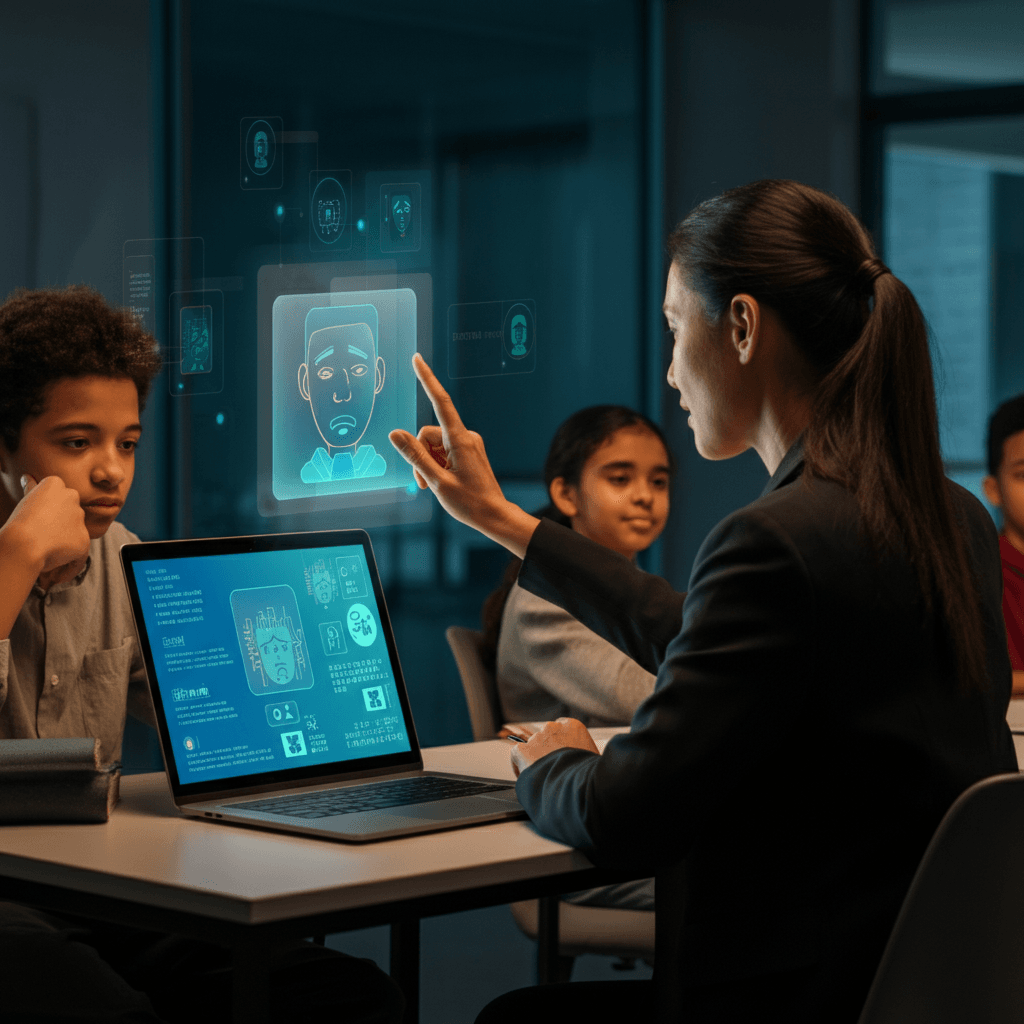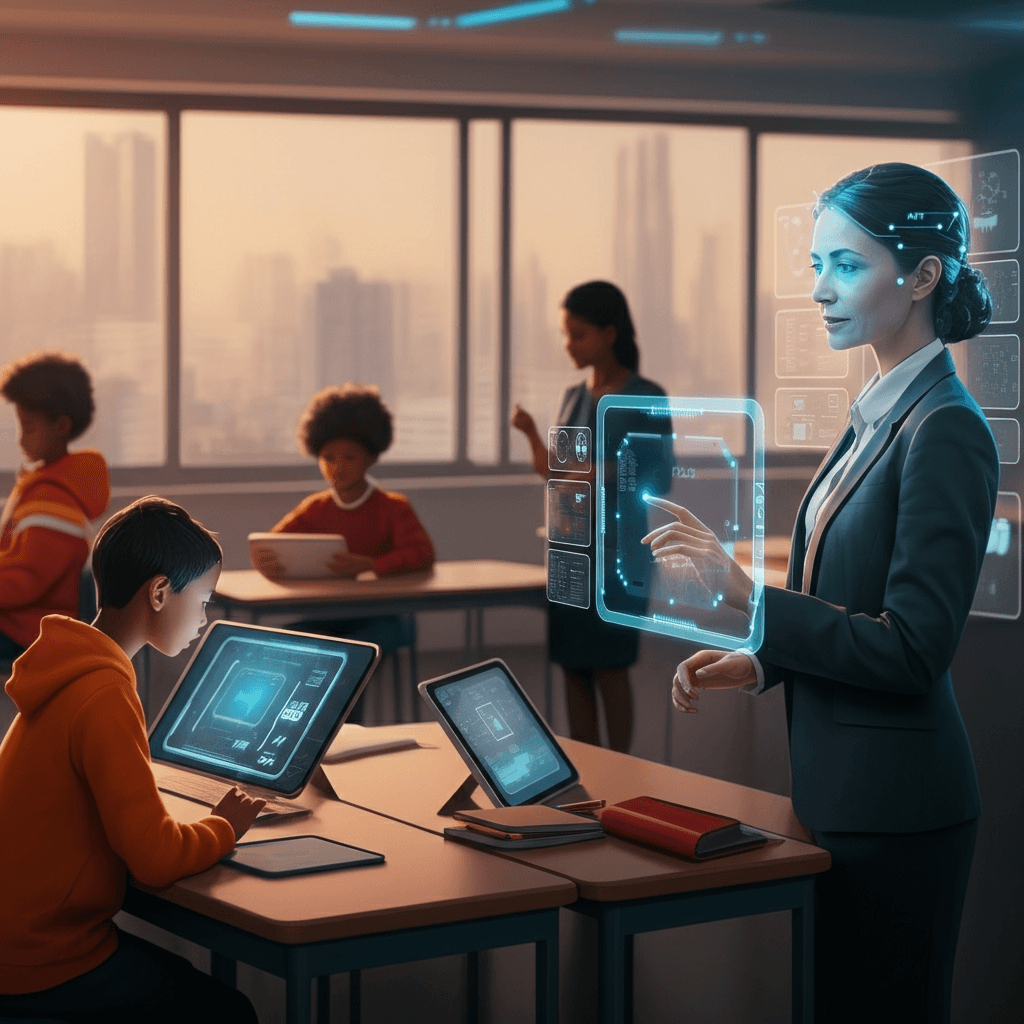Artificial intelligence (AI) is revolutionizing multiple sectors, and education is no exception. Schools, universities, and online learning platforms are now leveraging artificial intelligence in education to reshape teaching methods, enhance personalized learning, and provide scalable solutions to address challenges in education. Adaptive learning platforms, automated grading systems, AI chatbots, and virtual tutors exemplify how technology is redefining the learning experience—even beyond the classroom.
However, this transformation comes with its share of challenges. Educators and administrators must address issues such as data privacy, algorithmic bias, accessibility, and the digital divide. This article dives into the current state of AI in education, examining its benefits, real-world applications, and obstacles, while speculating on the future of AI-driven learning environments.
Adaptive Learning Platforms for Personalized Learning

One of the greatest benefits of AI in education is its ability to facilitate individualized learning. Adaptive learning platforms are at the forefront of this innovation, using algorithms to assess students’ strengths, weaknesses, and learning paces. These platforms tailor course content to individual needs, ensuring a more effective learning experience.
Real-World Example
Companies like DreamBox Learning focus on providing personalized math lessons for K-12 students. These platforms cater to different learning styles by using AI to tailor learning experiences to individual needs. Through AI, the system analyzes how students solve problems and adjusts the level of difficulty in real-time. Meanwhile, Carnegie Learning uses AI to provide adaptive mathematics and literacy solutions, incorporating insights from cognitive science to ensure students engage with material at their pace.
For higher education, platforms like Coursera and edX utilize AI to help students chart individualized courses and receive granular feedback, creating customized learning pathways. These tools are particularly beneficial for adult learners, who often balance education with work or other responsibilities.
Benefits
Individualized Pace: AI adapts coursework to match each student’s learning speed, effectively personalizing learning experiences.
Improved Retention: By closing gaps in understanding, adaptive learning helps students retain knowledge more effectively.
Scalability: Educators can handle larger groups of students while still addressing individual needs.
Challenges
Despite their advantages, adaptive learning platforms and AI technology require immense amounts of data to function effectively. This poses data privacy concerns and raises ethical questions regarding how student information is collected, stored, and used. Furthermore, students without consistent access to technology may struggle to benefit from these tools, exacerbating the digital divide.
Automated Grading Systems

Grading is a time-consuming task that often prevents educators from focusing on their primary role as facilitators. Automated grading systems powered by AI offer a solution by automating the evaluation process. These systems assess assignments, essays, quizzes, and exams faster and more consistently than human educators.
Real-World Example
Edtech tools like Gradescope employ AI to automatically grade multiple-choice exams, mark assignments with predefined rubrics, and even assess handwritten responses. These systems provide detailed feedback, highlighting students’ strengths and areas for improvement, which aids in enhancing their understanding and learning outcomes. Advanced systems can evaluate essay-based assignments by analyzing grammar, coherence, and content relevance.
This type of automation is also gaining traction in language learning applications. Duolingo, for instance, offers automated corrections in exercises, helping users understand their errors in real time.
Benefits
Efficiency: Saves teachers hours by automating repetitive tasks.
Consistency: Eliminates subjective bias in assessing student work.
Real-Time Feedback: Allows students to receive instant critique, aiding their learning process.
Grading Process: Integrates AI technologies to improve efficiency, precision, and fairness in evaluating student performance, reducing grading time and providing detailed feedback.
Challenges
AI grading systems, however, are not flawless. They may misinterpret unconventional answers or penalize creative approaches that fall outside predefined algorithms, lacking the immediate feedback that helps students understand their strengths and weaknesses. For teachers, relying on AI to evaluate subjective work can dilute the human element of education, where nuances in writing, critical thinking, and creativity often require personal judgment.
AI-Driven Toolkits for Teachers

The scope of AI extends beyond grading and adaptive learning. Teachers are now using AI powered tools for lesson planning, resource management, and student communication.
Real-World Example
AI chatbots, such as those used by platforms like Quizizz and Microsoft Teams, answer student inquiries, assist with scheduling, and provide learning recommendations. AI also helps in creating lesson plans, enabling educators to develop more effective and creative curriculums. Similarly, platforms like Canva have integrated AI features teachers use to create visually appealing presentations and assignments.
AI-driven data analytics tools also provide insights into student attendance, engagement, and performance. Systems like Classcraft analyze behavioral data, helping educators identify struggling students early and intervene appropriately.
Benefits
Enhanced Teaching Efficiency: AI tools reduce administrative tasks, allowing teachers more time to focus on pedagogy.
Insights into Learning Trends: Advanced analytics help educators predict performance issues and personalize attention for students who need it most.
Bridging Communication Gaps: AI chatbots provide immediate responses to FAQs, reducing delays in student support. Additionally, AI-enhanced educational platforms enable teachers to create interactive lessons that include instant feedback, personalized content, and inclusive resources, ultimately increasing student engagement and motivation.
Challenges
Introducing such tools not only benefits students by providing timely feedback but also depends heavily on robust IT infrastructure. Many schools, especially in underprivileged areas, lack the funds to integrate these technologies effectively. Additionally, overreliance on AI risks diminishing the personal connection between students and educators, which remains integral to effective learning.
AI in Online Learning

The rise of online learning has accelerated the demand for AI-driven solutions to enhance student learning. Platforms like Khan Academy and Udemy have adopted AI to provide personalized recommendations, quiz generation, and gamified content delivery. Beyond K-12 and higher education, corporate training programs now use AI to upskill employees with customized learning paths.
Real-World Example
Khan Academy’s AI-enhanced tools track a learner’s progress and suggest areas for improvement, while platforms like LinkedIn Learning use AI to recommend courses based on an individual’s skill gaps and career aspirations. AI helps students learn more effectively by providing personalized learning experiences and immediate feedback.
Virtual reality (VR) and augmented reality (AR) applications combined with AI have also started making inroads. For instance, Labster offers virtual lab simulations where students can conduct experiments in a realistic, immersive environment.
Benefits
Scalability for Distance Learning: AI allows platforms to provide quality education to users worldwide regardless of geography.
Data-Driven Learning: AI monitors progress and continuously adjusts content to offer the most effective learning experience. By analyzing educational data, AI provides actionable insights that help track student performance across various metrics, identify learning gaps, and adjust instructional strategies.
Engagement through Gamification: Students are motivated to progress through interactive AI-driven gamified platforms.
Challenges
AI technology creates unprecedented opportunities for online learners, but it also raises concerns about data security, particularly with younger users who may not fully understand the implications of sharing personal data. Additionally, access to high-speed internet and adequate devices remains a barrier for students in remote or underserved areas.
Addressing Data Privacy and Bias
AI technology brings significant benefits to education, but it also poses serious challenges related to data privacy and algorithmic bias. AI systems often require vast amounts of data to function effectively. Without strong cybersecurity measures and transparent practices, this data can be vulnerable to breaches or misuse.
Algorithmic Bias
AI technology systems trained on flawed or limited datasets risk perpetuating stereotypes or prejudices. For example, an AI tool may unintentionally disadvantage students from certain demographic or linguistic backgrounds, creating inequity in learning outcomes.
Privacy Concerns
AI technology has raised concerns among parents and educators about the implications of collecting sensitive student data. Regulations like the General Data Protection Regulation (GDPR) and the Family Educational Rights and Privacy Act (FERPA) aim to address these concerns, but enforcement and compliance remain challenging, especially in rapidly evolving digital environments.
Bridging the Digital Divide
While AI’s benefits are vast, its uneven accessibility highlights the persistent issue of the digital divide. To utilize AI-driven tools, students need access to reliable internet and devices. Unfortunately, schools in low-income or rural areas often struggle to provide these resources.
Efforts are being made to mitigate this divide. Nonprofits and governments worldwide are working to expand internet access and equip schools with affordable technology. For example, the One Laptop per Child (OLPC) initiative focuses on providing affordable devices in underprivileged regions.
The Future of AI in Education

The educational landscape is poised to evolve rapidly with the advancement of AI technology. Here are some trends on the horizon:
Emotion AIEmotion AI, designed to gauge the emotional states of students during lessons, could help teachers adapt real-time instruction. By analyzing facial expressions or vocal patterns, these tools could identify when students are struggling or disengaged.
Multilingual SupportAI translation tools will further break down barriers for non-native speakers, offering inclusive and equitable learning experiences across languages.
Holistic Learning PlatformsIntegrated platforms could combine multiple AI capabilities, such as adaptive learning, grading, and analytics, into a single interface for educators and students.
Upskilling EducatorsProfessional development for teachers will shift toward integrating AI in classrooms effectively, ensuring educators maximize the potential of AI tools while preserving the human element.
Final Thoughts
AI technology is reshaping education by providing innovative tools that improve learning outcomes, streamline administrative workloads, and enhance accessibility. However, its adoption comes with challenges including data security, fairness, and the risk of inequality in access.
For AI to fully realize its potential in education, stakeholders must focus on collaboration between policymakers, tech developers, and educators. By addressing ethical concerns and ensuring wide accessibility, AI can transform education into a tool that works for every learner, regardless of location or socioeconomic status.
